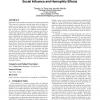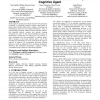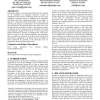977 search results - page 5 / 196 » How probes inform and influence the design process |
CHI
2009
ACM
14 years 8 months ago
2009
ACM
Exertion games are an emerging form of interactive games that require players to invest significant physical effort as part of the gameplay, rather than just pressing buttons. The...
WWW
2010
ACM
13 years 7 months ago
2010
ACM
Relational autocorrelation is ubiquitous in relational domains. This observed correlation between class labels of linked instances in a network (e.g., two friends are more likely ...
IEEEIA
2009
13 years 5 months ago
2009
In this paper we propose the CTS (Concious Tutoring System) technology, a biologically plausible cognitive agent based on human brain functions.This agent is capable of learning a...
ACMDIS
2008
ACM
13 years 9 months ago
2008
ACM
Participatory Design is a design approach that provides a popular set of techniques for designing interactive systems in collaboration with end-users. Technology probes are one of...
OZCHI
2006
ACM
14 years 1 months ago
2006
ACM
The project is working towards building an understanding of the personal interests and experiences of children with the aim of designing appropriate, usable and, most importantly,...




